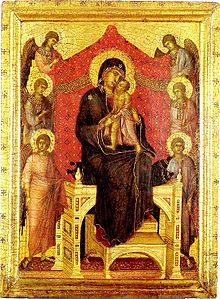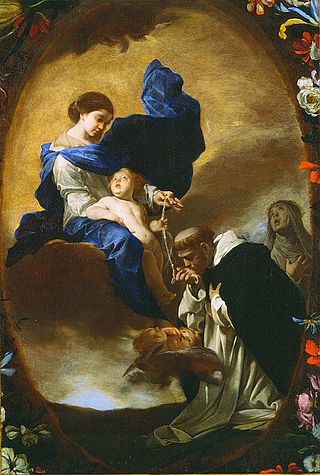
The Rosary, also known as the Dominican Rosary, refers to a set of prayers used primarily in the Catholic Church, and to the physical string of knots or beads used to count the component prayers. When referring to the prayer, the word is usually capitalized ; when referring to the prayer beads as an object, it is written with a lower-case initial letter.

The Litany of the Blessed Virgin Mary is a Marian litany originally approved in 1587 by Pope Sixtus V. It is also known as the Litany of Loreto, after its first-known place of origin, the Shrine of Our Lady of Loreto (Italy), where its usage was recorded as early as 1558.

The Angelus is a Catholic devotion commemorating the Incarnation of Christ. As with many Catholic prayers, the name Angelus is derived from its incipit—the first few words of the text: Angelus Domini nuntiavit Mariæ. The devotion is practised by reciting as versicle and response three Biblical verses narrating the mystery, alternating with the prayer "Hail Mary". The Angelus exemplifies a species of prayers called the "prayer of the devotee".

In Catholic tradition, the Five Holy Wounds, also known as the Five Sacred Wounds or the Five Precious Wounds, are the five piercing wounds that Jesus Christ suffered during his crucifixion. The wounds have been the focus of particular devotions, especially in the late Middle Ages, and have often been reflected in church music and art.
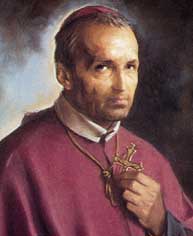
Alphonsus Liguori, CSsR, sometimes called Alphonsus Maria de Liguori or Saint Alphonsus Liguori, was an Italian Catholic bishop, spiritual writer, composer, musician, artist, poet, lawyer, scholastic philosopher, and theologian. He founded the Congregation of the Most Holy Redeemer, known as the Redemptorists, in November 1732.

The "Salve Regina", also known as the "Hail Holy Queen", is a Marian hymn and one of four Marian antiphons sung at different seasons within the Christian liturgical calendar of the Catholic Church. The Salve Regina is traditionally sung at Compline in the time from the Saturday before Trinity Sunday until the Friday before the first Sunday of Advent. The Hail Holy Queen is also the final prayer of the Rosary.

Marian devotions are external pious practices directed to the person of Mary, mother of God, by members of certain Christian traditions. They are performed in Catholicism, High Church Lutheranism, Anglo-Catholicism, Eastern Orthodoxy and Oriental Orthodoxy, but generally rejected in other Christian denominations.
Confraternities of the Cord are pious associations of Christians, the members of which wear a cord, girdle or cincture in honour of a saint whom they wish to honour and emulate.
Purgatorial societies are Roman Catholic Church associations or confraternities which aim to assist souls in purgatory reach heaven. The doctrine concerning purgatory, the condition of the poor souls after death, the communion of saints, and the satisfactory value of our good works form the basis of these associations.

The Roman Catholic Bona Mors Confraternity was founded 2 October 1648, in the Church of the Gesu, Rome, by Father Vincenzo Carafa, seventh General of the Society of Jesus. In 1729 it was raised to an archconfraternity by Benedict XIII. The object of the association is to prepare its members by a well-regulated life to die in peace with God.
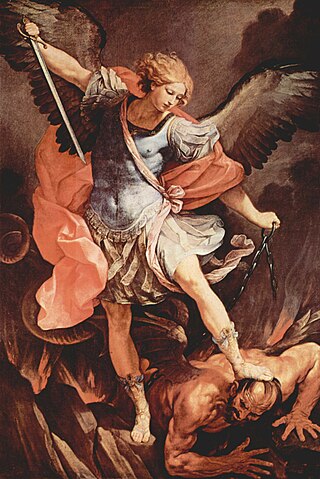
The Chaplet of Saint Michael the Archangel, also called the Rosary of the Angels, is a chaplet approved by Pope Pius IX in 1851.

Rosary-based prayers are Christian prayers said on a set of rosary beads, among other cords. These prayers recite specific word sequences on different parts of the rosary beads. They may be directed to Jesus Christ, the Virgin Mary or God the Father.

Throughout history, Catholic Mariology has been influenced by a number of saints who have attested to the central role of Mary in God's plan of salvation. The analysis of Early Church Fathers continues to be reflected in modern encyclicals. Irenaeus vigorously defended the title of "Theotokos" or Mother of God. The views of Anthony of Padua, Robert Bellarmine and others supported the doctrine of the Immaculate Conception of the Virgin Mary, which was declared a dogma in 1850.

The veneration of Mary in the Catholic Church encompasses various devotions which include prayer, pious acts, visual arts, poetry, and music devoted to her. Popes have encouraged it, while also taking steps to reform some manifestations of it. The Holy See has insisted on the importance of distinguishing "true from false devotion, and authentic doctrine from its deformations by excess or defect". There are significantly more titles, feasts, and venerative Marian practices among Roman Catholics than in other Western Christian traditions. The term hyperdulia indicates the special veneration due to Mary, greater than the ordinary dulia for other saints, but utterly unlike the latria due only to God.

The Feast of the Most Holy Name of the Blessed Virgin Mary is an optional memorial celebrated in the liturgical calendar of the Catholic Church on 12 September. It has been a universal Roman Rite feast since 1684, when Pope Innocent XI included it in the General Roman Calendar to commemorate the victory at the Battle of Vienna in 1683. It was removed from the Church calendar in the liturgical reform following Vatican II but restored by Pope John Paul II in 2002, along with the Feast of the Holy Name of Jesus.
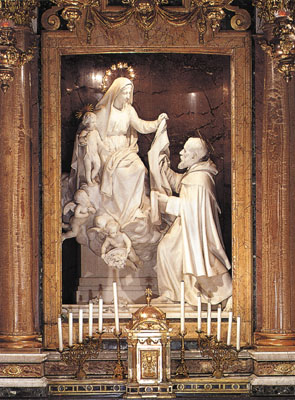
The exact origins of both the rosary and scapular are subject to debate among scholars. Pious tradition maintains that both the rosary and the brown Scapular of Our Lady of Mount Carmel were given by the Virgin Mary to Dominic and Simon Stock respectively during the 13th century. Historical records document their growth during the 16th and 17th centuries in Europe. By the early 20th century, they had gained such a strong following among Catholics worldwide that Josef Hilgers, writing in the Catholic Encyclopedia of 1914, stated: "Like the Rosary, the Brown scapular has become the badge of the devout Catholic."

The Chaplet of the Seven Sorrows, also known as the Rosary of the Seven Sorrows or the Servite Rosary, is a Rosary based prayer that originated with the Servite Order. It is often said in connection with the Seven Dolours of Mary.

The Glories of Mary is a classic book in the field of Roman Catholic Mariology, written during the 18th century by Saint Alphonsus Liguori, a Doctor of the Church.

There are differing views on the history of the rosary, a Christian prayer rope, cord or chain used to count specific prayers, commonly as a Marian devotion. The exact origin of the rosary as a prayer is less than clear and subject to debate among scholars. The use of knotted prayer ropes in Christianity goes back to the Desert Fathers in the 3rd and early 4th centuries. These counting devices were used for prayers such as the Jesus prayer in Christian monasticism. The period after the First Council of Ephesus in 431 witnessed gradual growth in the use of Marian prayers during the Middle Ages.
The rosary is one of the most notable features of popular Catholic spirituality. According to Pope John Paul II, rosary devotions are "among the finest and most praiseworthy traditions of Christian contemplation." From its origins in the twelfth century the rosary has been seen as a meditation on the life of Christ, and it is as such that many popes have approved of and encouraged its recitation.


